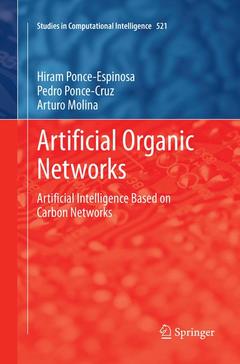Artificial Organic Networks, 2014 Artificial Intelligence Based on Carbon Networks Studies in Computational Intelligence Series, Vol. 521
Auteurs : Ponce-Espinosa Hiram, Ponce-Cruz Pedro, Molina Arturo

This monograph describes the synthesis and use of biologically-inspired artificial hydrocarbon networks (AHNs) for approximation models associated with machine learning and a novel computational algorithm with which to exploit them. The reader is first introduced to various kinds of algorithms designed to deal with approximation problems and then, via some conventional ideas of organic chemistry, to the creation and characterization of artificial organic networks and AHNs in particular.
The advantages of using organic networks are discussed with the rules to be followed to adapt the network to its objectives. Graph theory is used as the basis of the necessary formalism. Simulated and experimental examples of the use of fuzzy logic and genetic algorithms with organic neural networks are presented and a number of modeling problems suitable for treatment by AHNs are described:
· approximation;
· inference;
· clustering;
· control;
· classification; and
· audio-signal filtering.
The text finishes with a consideration of directions in which AHNs could be implemented and developed in future. A complete LabVIEW? toolkit, downloadable from the book?s page at springer.com enables readers to design and implement organic neural networks of their own.
The novel approach to creating networks suitable for machine learning systems demonstrated in Artificial Organic Networks will be of interest to academic researchers and graduate students working in areas associated with computational intelligence, intelligent control, systems approximation and complex networks.
Professor Dr. Arturo Molina is Rector of Mexico City Metropolitan Area of Tecnologico de Monterrey. Former General Director of Campus Ciudad de Mexico, Vice president of Research and Technological Development, and Dean of the School of Engineering and Architecture of Campus Monterrey. He was a visiting professor at UC Berkeley at Mechanical Engineering Department during his Sabbatical year. He received his PhD degree in Manufacturing Engineering at Loughborough University of Technology, England in July 1995, his University Doctor degree in Mechanical Engineering at the Technical University of Budapest, Hungary in November 1992, his M.Sc. degree and BSc. in Computer Science from Tecnologico de Monterrey, Campus Monterrey. Professor Molina is member of the National Researchers System of Mexico (SNI-Nivel II), Mexican Academy of Sciences, Member of the IFAC Council, and member of IFIP WG5.12 Working Group on Enterprise Integration Architectures and IFIP WG 5.3 Cooperation of Virtual Enterprises and Virtual Organizations. He has offered seminars and conferences in USA, Canada, Latin America and Europe and is in the Editorial Board of the International Journal of Computer Integrated Manufacturing, Annual Reviews in Control and International Journal of Networking and Virtual Organisations. He has worked as a consultant for important Mexican corporations, World Bank, Inter-American Development Bank (IADB) and United Nations Information and Communication Technologies (ICT) Task Force. He has been Latin American coordinator of important international projects related to the development of Information Technologies such as: COSME-GVE (Cooperation of Small and Medium Enterprises - Global Virtual Enterprise), ENAPS (European Network for Advanced Performance Studies), e-HUBS (e-Engineering enabled by Holonomic and Universal Broker services) and Global e-Engineering (Global Collaborative Engineering Environment for Integrated Product Development using Internet 2). Healso par
Date de parution : 04-2017
Ouvrage de 228 p.
15.5x23.5 cm
Date de parution : 11-2013
Ouvrage de 228 p.
15.5x23.5 cm


